Renowned for colorful flowers that often have detailed markings, irises are some of the most popular cottage garden plants. As a former professional gardener, I have grown many different species belonging to the Iris genus, ranging from flamboyant bearded irises in borders to miniature varieties for pot displays.
There are over 300 Iris species growing worldwide, most of which are native to Europe and Asia. However, there are 28 species native to North America, many of which are rare or threatened. As many of these native species grow in fragile ecosystems, such as meadows, swamps or wetlands, it is important, where possible, to grow and nurture these special irises.
So, if you are considering what native planting to add to your yard, why not consider some of the best non-bearded iris varieties found across North America? Our guide has all the necessary information, including planting tips to get them in the ground and established during the fall months.
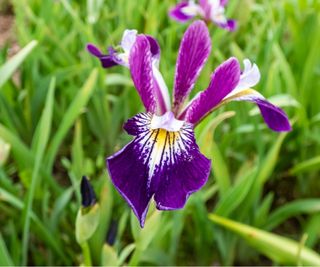
The Rocky Mountain iris, Iris missouriensis, is a hardy native species with detailed markings
(Image credit: Kristine Radkovska via Getty Images)
5 best native irises
If you know how to grow irises, you will not need any convincing of how impressive this plant family is. While ranging in color, shape and size, most iris varieties are recognizable for having upright petals (standards), and dropping sepals (falls), creating a firework-like display that you can see in the images here.
Native irises are found growing across all of the lower 48 states and in Alaska, ranging from high elevations and alpine-like environments across the Rocky Mountains, to the low swamp and marshlands in the lower Mississippi River valley. While there is much variety, we take a look at the five best native irises to plant in the fall.
1. Southern Blue Flag Irises
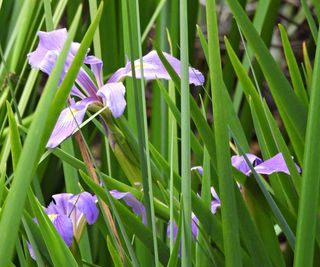
For a wet or damp yard, the blue flag iris, Iris virginica, is a good option
(Image credit: Getty Images/Sandi Smolker)
If you are looking for backyard ideas and keen to learn how to grow blue flowers, then the southern blue flag iris, Iris virginica, should be at the top of your list. This native species can be grown from US hardiness zone 5 to US hardiness zone 9.
The southern blue flag iris is typically found growing in Virginia, south to Georgia and Florida, and west to Texas, producing vertical growth to two or three feet tall. Atop these stems, violet-blue blooms will open and prove popular plants for pollinators.
Rhizomes can be planted in garden borders from July through to November, while potted plants can be planted until the end of November. Position these native irises in full sun but note that they enjoy having wet roots, so planting them at the edge of a pond is a good idea.
‘We grow several different types of Iris at Oudolf Garden Detroit,’ says Meredith Simpson, horticulturist and leading grounds crew member at the Oudolf Garden.
‘Visitors love seeing our reblooming irises both in early summer and in fall. In particular, our native blue flag iris, Iris virginica, is wonderful for moist soils and rain gardens. This strong performer blooms a pale blue in late spring and summer and has gorgeous fresh green foliage all season.’
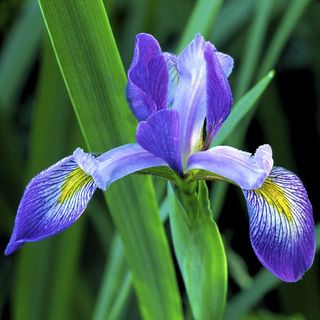
This native iris has striking purple and yellow markings, sure to add impact to any border in your yard.

Meredith Simpson is a leading member of the Oudolf Garden Detroit’s grounds crew, managing the garden’s plant sourcing, operations and maintenance efforts. She is a long-time perennial gardener with a particular interest in modern planting design and environmental stewardship.
2. Bristle-Pointed Irises
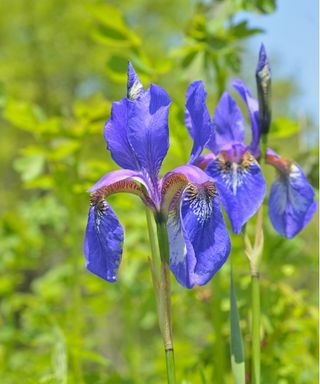
With rich, blue flowers, the bristle-pointed iris, or Iris setosa, pairs nicely with other blue, purple or white blooms
(Image credit: KirsanovV via Getty Images)
The bristle-pointed iris, or Iris setosa, is a beautiful choice if you reside in cooler, northerly regions. Found growing across much of Canada and Alaska, the tough species can be grown from US hardiness zone 3 to US hardiness zone 8, able to survive harsh, frozen winters without much trouble.
With a preference for full sun or part shade, the bristle-pointed iris will grow no taller than two feet. This species can be grown from seed in a cold frame or greenhouse in the fall and planted outside the following spring.
If you have an established clump in the yard, you can learn when to divide plants, which should be done for this species in October and November.
Bristle-pointed iris seeds can be bought online from Amazon.
3. Dwarf Crested Irises
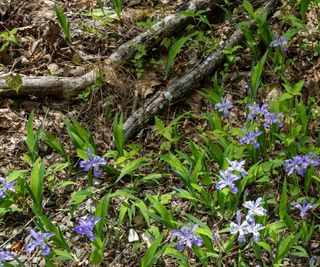
For a low-growing option, the dwarf crested iris, Iris cristata, is small but impactful with purple flowers
(Image credit: Getty Images/aimintang)
The dwarf crested iris, or Iris cristata, is a small rhizomatous perennial often seen growing as a ground cover plant and typically reaching no taller than five or six inches.
This native species can be grown from US hardiness zone 4 and above, with a preference for woodland-like environments with some protection from the afternoon sun in slightly damp, loamy soils.
Dwarf crested irises can be planted in the spring or fall months, with shallow planting preferable, as is the case for most rhizomatous plants. Over time, this low-growing iris will spread and creep, creating a carpet-like effect of violet blooms in the summer months.
Iris cristata rhizomes are available to order from Amazon.
4. Louisiana Irises
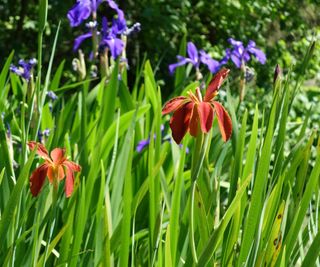
An unusual shape with an open form, the copper or Louisiana iris, Iris fulva, has unusual red blooms
(Image credit: Alamy/Zoonar GmbH )
The Louisiana iris, Iris fulva, produces unusual copper-red flowers that attract bees and butterflies in the spring and summer. Stems range in height from two to three feet tall, and this species thrives in bog, marsh or wetland environments, found growing in alluvial soils across Louisiana and Mississippi.
Iris fulva can be grown from US hardiness zone 6 to zone 9, with a preference for full sun and wet soil, making this an ideal option for a rain garden in an open, unobstructed site.
Plant Louisiana irises in springtime or early fall. You can plant them as late as November in mild regions or where winter arrives later in the year.
Louisiana irises, or copper irises, are available as live plants from Nature Hills.
5. Douglas Iris
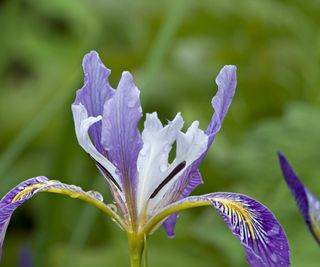
With yellow and purple narrow petals, the Douglas iris, Iris douglasiana, is found growing across California
(Image credit: Getty Images/Ed Reschke)
If you are looking for California native planting, the Douglas iris, Iris douglasiana, is an elegant species to consider. Found growing across the Pacific coast in California and Oregon, this wild species has a preference for sunshine and moist soil.
The Douglas iris can be grown from US hardiness zone 7, reaching no more than two feet tall. There are many impressive varieties supplied by nurseries, such as the cream-white ‘Canyon Snow’. Be warned, however, in grasslands and meadows this species is vigorous and can be considered an invasive plant. Contact your local municipal office to learn more about what should and should not be grown in your region.
‘Irises are show stopping perennials that naturally grow in the moist ranges of California,’ says Maya Argaman, native plant expert and Horticulture Senior Program Coordinator at the California Native Plant Society.
‘With showy flowers emerging in the spring to add delight and elegance to gardens, who wouldn’t love irises? They tolerate poor drainage and high moisture, thriving when planted next to a creek or in a naturally wet area.’
If you already have a clump of Douglas iris, you can divide the rhizome in the fall, usually around October or November, or you can grow this species from seed, sowing undercover in a greenhouse in the fall.

Maya is the Horticulture Senior Program Coordinator at the California Native Plant Society. She graduated from UC Davis with a degree in Environmental Science and Management, where she fell in love with native plants in both the natural and built environment.
FAQs
When should I prune my native irises?
If you are wondering when to cut back irises, it is best to consider this job as part of your fall gardening checklist. Always leave the iris foliage to turn yellow and brown, thereby allowing the plant to return as much energy as possible to the rhizome or bulb. After the first frost, the foliage will flop and fade. At this point, you can cut down to the base of the plant.
For more iris information, take a look at our guide on how to grow bearded irises. While not native to North America, some of these varieties are remarkably ornamental and decorative. I have previously grown many different varieties of Iris germanica, including ‘Medici Prince’, which has deep maroon falls with a yellow center. Quite a show stopping iris, by any standard.
Known for their colorful flowers with intricate markings, irises are popular plants in cottage gardens. With experience as a professional gardener, I have cultivated various species of irises, from flamboyant bearded irises in borders to miniature varieties for pot displays.
There are over 300 species of irises worldwide, with most native to Europe and Asia. However, North America is home to 28 native species, some of which are rare or endangered. It is crucial to grow and protect these native irises, especially those found in delicate ecosystems like meadows, swamps, and wetlands.
If you’re thinking about adding native plants to your yard, consider some of the best non-bearded iris varieties in North America. Our guide provides all the necessary information, including planting tips for fall establishment.

(Image credit: Kristine Radkovska via Getty Images)
5 best native irises
If you’re familiar with growing irises, you know how impressive these plants can be. While they vary in color, shape, and size, most iris varieties are known for their upright petals (standards) and dropping sepals (falls), creating a fireworks-like display.
Native irises grow across the lower 48 states and Alaska, from high elevations in the Rocky Mountains to low swampy areas in the lower Mississippi River valley. Here are the five best native irises to plant in the fall.
1. Southern Blue Flag Irises
If you’re interested in blue flowers and wet environments, the southern blue flag iris, Iris virginica, is a great choice. This native species thrives in US hardiness zones 5 to 9 and can reach heights of two to three feet. Plant them in full sun with wet roots, making them ideal for pond edges.

For a wet or damp yard, the blue flag iris, Iris virginica, is a good option
(Image credit: Getty Images/Sandi Smolker)
We grow various Iris types at Oudolf Garden Detroit, including the native blue flag iris, Iris virginica, which thrives in moist soils and rain gardens, blooming pale blue in late spring and summer.

This native iris has striking purple and yellow markings, sure to add impact to any border in your yard.
